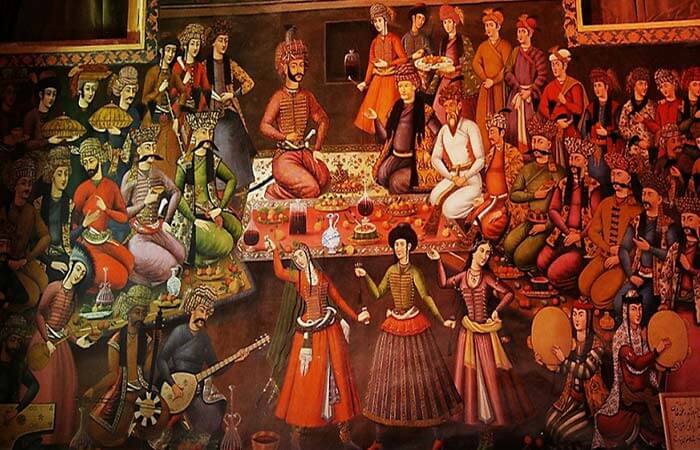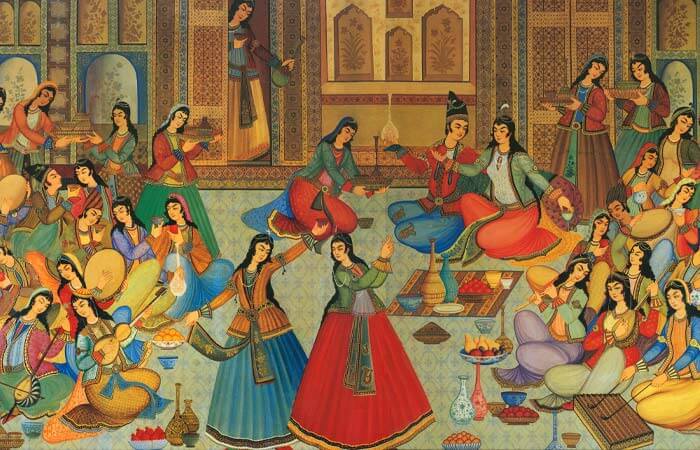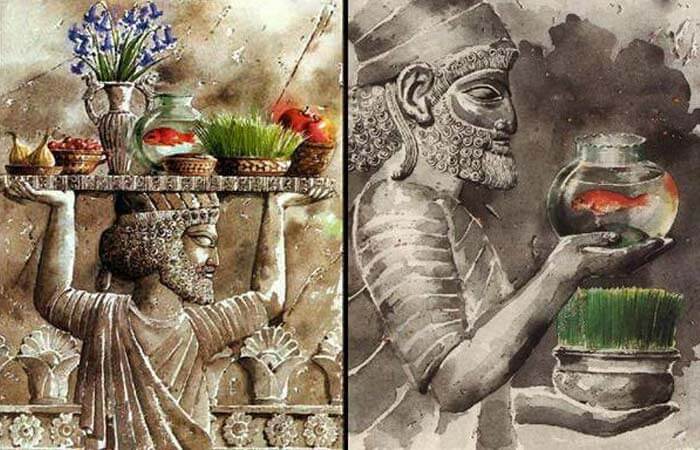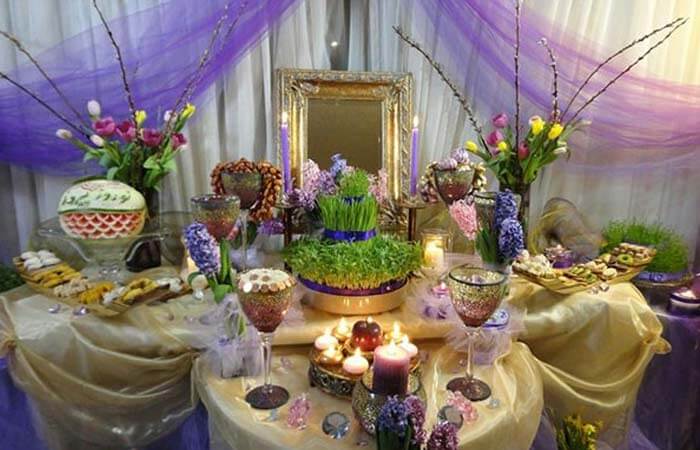
Nowruz, the beginning, past and present
Nowruz is the celebration of New Year in Iran. On this day, the Iranian calendar that is based on the solar movement advances one year. The most important and generally celebrated festivity of Nowruz is held on the first day of Farvardin, around March 20. Like any other celebration of the same magnitude and age, Nowruz is significant in history, mythology and culture. Here, we will first talk about Iranian chronometry and then Nowruz, its tradition and customs today and a great Adventure in Iran. You can experience Nowruz in Iran in a Damavand trekking tour for a new and exciting experience.
Iranian Chronometry
In ancient time, Iranian calendar had 12 months and each month had 30 days. The months as well as the days were named after a god/goddess and that god/goddess was the protector of that day. For the process of naming, then, they had a two-part and four-part division. The two-part division divided the month to two 15-days. The first day was always named after the god of gods and creator of all Ahura Mazda while the second one was named after Mithra or Mehr. In the four-part division, however, the month had 2 7-days and 2 8-days part. The first part began with the name of Ahura Mazda, and the rest began with the name of Dey meaning the creator. To avoid confusion, they called the three Deys with the name of their following day.
For the seasons, they broke the mentioned 12 months down to six unequal parts following a myth that I will tell you all about now. In this myth, the whole creation took 12 thousand years; notice the repetition of number 12. For the first three thousand years, we had the invisible world of Ahura and Ahriman. The world of Ahura is pure and you can find all that is good there, while the world of Ahriman is evil and bad. In this three thousand years, the two world coexist together. In the second three thousand years, Ahura gets to put Ahriman to a sleep and in the absence of evil, he creates the sample form of sky, water, earth, plant, cattle, and human. The philosophy of the 6 seasons comes from this. A season for each creation, a celebration for each creation.
Iranian called these celebration Gahanbar and they were celebrated generally and with much passion. Here are these six celebrations.

Maidh-yo-zarem:
The first Gahanbar, celebrating the creation of sky. It literary means the mid-spring celebrated from 11 to 15 of Ordibehesht, the second month of Iranian current calendar.
Maidh-yo-shema:
The second Gahanbar, celebrating the creation of water. It literary means the mid-summer celebrated from 11 to 15 Tir, the fourth month of Iranian current calendar.
Paiti-shahem:
The third Gahanbar, celebrating the creation of earth and celebrated in the last day of Shahrivar, the sixth month of Iranian current calendar.
Aya-threm:
The fourth Gahanbar, celebrating the creation of plants. It literary means return referring to the time that the shepherds return the herd back. It is celebrated at the beginning of winter.
Maidh-ya-rem:
The fifth Gahanbar, celebrating the creation of cattle. It literary means mid-year.
Hamas-path-maedem:
The last Gahanbar, celebrating the creation of humans. It literary means gathering together. It was celebrated in the six last days of the leap year. The last day was the highlight of celebration and known as the Great Nowruz. It makes Nowruz, among other things, a celebration of creation of human.
Nowruz in Myth
Our mythology attributes Nowruz to the great king Jamshid. In these stories, which are plenty in number and various in plot, Jamshid fights with the Ahriman and defeats him. The realm is full of darkness and evil, nothing grows, nothing survives and Jamshid leaves this world to go to the realm of evil and fight Ahriman. He successfully defeats the evil and when he returns, sun is shining, plants have grown and the land is yet again prosperous. People celebrate and call this day, a new day or Nowruz in Farsi. There are other tales regarding Jamshid and his victories which at the end of all they call this day Nowruz and celebrate it.
With the advent of Islam in Iran and the cultural combination that resulted, prophet Solomon replaced Jamshid. In this version, Solomon loses his ring and as a result his kingdom. It takes him 40 days to find the ring again and take back his power to rule. Iranian call the day that Solomon reclaim his throne as the new day or Nowruz.

Nowruz in History
As mentioned, what we know from Nowruz through history begins with Sassanid Dynasty. In this time, Nowruz was a 6-days celebration with the last day being the main celebration and called the celebration of great Nowruz. The celebration went like this. Each day, the king received a group of people where they talked about their problems and gave king some gifts. First day belonged to commoners, second day to farmers, third day to Zoroastrian priest, fourth day to royals, fifth day to king’s family and the last day to king himself.
On the last day, and right in the midnight, a handsome pious man would go to the king chambers preaching and praying for a bountiful year. Then trays of gold, seeds, and plants were brought for the king. Another important tradition happened 20 to 25 days before the Nowruz. People made 12 pillars out of bricks and plant one seed over the top, on the Nowruz, they checked the pillars to see which of the seed grow better. That seed was the main product of the year. They believed it will grow better on that year.
Nowruz Now
Although still Nowruz is filled with traditions, many of the previous ones are no longer performed. The trays of king were replaced by seven item that starts with the letter س or the sound /s/ later accompanied by three or four other items. Each of the item represent something. They are placed over the table that the whole family gather around and celebrate the changing of the year together. The items include:
- Grass and Hyacinths representing greenery and nature
- Apple representing birth and fertility
- Samanu, the sweet paste representing wheat and agriculture
- Oleaster representing love and passion
- Garlic representing health
- Sepand, the Incense that represent holiness
- Holly book representing knowledge
- Mirror for the reflection of light
- Candle representing fire and light
- Eggs representing fertility
- Gold fish representing activity
- And edibles representing blessing

Nowruz Traditions: Gatherings and Presents
Nowruz as the New Year Eve is the most important festival in Iran. Iranian welcome spring with this festival and its many traditions. In a previous post, we discussed the history of Nowruz and named the traditions that are part of it. You can read more about them in the links. Here, we want to talk a little about one of these traditions. To do so, let’s imagine you are in Iran and its Nowruz, we begin going through what will happen.
Nowruz the Tradition of Families
Naturally, and just like the Christian New Year, this festivity is a time for family. Therefore, the family is at the center. Moreover, the time of New Year changes every year and with that the order of celebration. Nonetheless, before the New Years’ time, you have to get ready and head to your parents’ house, or perhaps the grandparents’ house to be together when the New Year is announced. Now, as you are standing next to the Haft Sin table, with your parents and family the TV shows and a booming sound tells you that the New Year has come.
What is next? You and your whole family begin hugging and congratulating each other. Then, you all go outside the house to throw out the negativity and then return with positive energy. Next, it’s time for the presents. While many today exchange presents, traditionally the present is money. The seniors of the family would give money to their children and grandchildren, or all who are younger than them. The money is usually placed in the Quran, the holy book of Islam. The amount depends on the financial status and how close the relation is. This tradition is called giving or receiving Eidi. At last, it’s time for vegetable rice and fish.
You have already visited your closest family, however, there are still many relatives that you haven’t seen. In the Nowruz holiday, you have enough time to visit all of them, all aunts, uncles, and cousins. This tradition is called Eid Didani in Farsi including two words of Eid meaning festival, celebration, and Didani meaning visiting. For many teenagers, this tradition is pure torture. They have to visit some relatives they see once a year, be on their best behavior, and answer a lot of questions about their life.

Bottom line
In general, the traditions of this celebration includes Haft Sin, cleaning of the house, Chahar Shanbe Soori, meeting relatives and friends, giving and receiving gifts, Sizdah be Dar, and visiting the graves of deceased.






